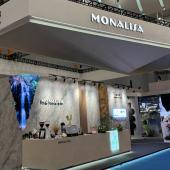Fall in ceramic machinery industry turnover
Total turnover fell from 1,523 to 1,452.5 million euro, a reduction 70.5 million euro in absolute terms of. The most substantial falls concerned exports, down from 1,033.2 to 968.5 million euro (-6.3% or 64.7 million euro).
This was the first decrease after three years of growth. The share of total sector turnover generated by exports remained stable at 66.7%. Sales of machinery in the Italian market continued at 2001 levels, down from 489.8 to 484 million euro (-1.2% or 5.8 million euro).
These are the figures that emerge from the 11th Annual National Statistical Survey conducted by Acimac and unveiled the day before the Annual Meeting, to be held on the afternoon of Friday 6 June in Spezzano Castle (province of Modena).
The Acimac report also revealed a particularly sharp fall in sales of tile manufacturing machinery (-4.9% in Italian market and -6.1% abroad), while turnover in the other segments (machinery for bricks, tableware, sanitaryware and refractories) remained substantially stable.
The European Union remained the leading export area, in spite of a fall in sales for the second year running (-26.4%), while the Middle East became the second largest export market (accounting for 15.9% of total exports) due to an increase in sales that has continued uninterruptedly since 1999. In 2002 the turnover registered in this area totalled 153.9 million euro (35.9% up on 2001).
The in-focus section contains:
Italian companies
Client sectors
Types of machinery
Markets
Forecasts for 2003
There is also a downloadable file containing the figures from the statistical survey
After closures, setting up of new companies and consortia, mergers and takeovers, the number of Italian ceramic machinery manufacturers operating in the year 2002 totalled 173 (6 fewer than in 2001).
This fall was partly due to a number of companies shifting towards a sub-supply or supply activity to sectors outside the ceramic industry, a common tendency during periods of slowdown in demand from the ceramic sector.
The year 2002 confirmed the now well-established breakdown of machinery sales to the six different client ceramic sectors, namely manufacturers of tiles, sanitaryware, heavy clay products, tableware, refractories and various ceramic products.
The tile industry, which accounts for 81.3% of the sector�s total turnover, was the segment contributing most to the sharp fall in total sales volumes. The value of sales for tile production fell from 1,251.6 to 1,180.3 million euro (5.7% down on 2001, a drop of 71.3 million euro).
Sales in Italy fell by 4.9% against 2001 to 373.2 million euro, a drop of more than 19 million euro. However, exports in this segment fared worse, declining to 807.2 million euro (6.1% or 52 million euro down on 2001).
As regards other types of ceramic machinery, there was an increase in sales of brick and tile machinery (from 156 to 160 million euro), sanitaryware machinery (from 64.6 to 66.6 million euro) and refractory machinery (from 7.8 to 9.3 million euro).
In contrast, there was a fall in sales of tableware machinery (from 35.5 to 29.8 million euro) and machinery for various ceramic products (from 7.6 to 6.4 million euro). T
hese turnover volumes are relatively small and have remained essentially stable over the past 5 years in absolute terms (in spite of sometimes significant percentage variations).
In 2002 there was little substantial change in the value of sales of individual machinery types. Amongst the core machines in the ceramic production process, machines for product forming (presses and moulds) strengthened their position to reach 25.2% of total turnover (9.9% higher than in 2001).
There was likewise an increase in the percentage of glazing and decoration systems (2% up on 2001) and a fall in sales of firing systems (-9.2%) and earth preparation machinery (-15.3%).
Although the European Union remained the leading export area, it showed a sharp fall in sales for the second year running (-26.4%), down from 336.5 to 247.6 million euro. Its share of total foreign turnover fell to 25.6%.
A major factor behind the lower demand for technology in this area was certainly the worsening difficulties experienced by the Spanish tile industry in its reference markets.
The year 2001 trend was also confirmed in the Middle East, now the second largest export market (accounting for 15.9% of total exports) following an increase in sales that has continued uninterruptedly since 1999.
In 2002 this area recorded a turnover of 153.9 million euro (35.9% up on 2001).
A similar trend was shown by demand from the Eastern European countries, which has likewise increased constantly since 1997. In 2002 sales reached 127.7 million euro (13.8% up on 2001).
In both the Middle East and Eastern Europe the growth in demand for technology is due to the progressive and continuous development of a burgeoning local ceramic industry, which is expected to expand further in the future.
The Asian markets (with the exception of China) instead suffered a sharp downturn. After two years of two-figure growth, sales plummeted to 132.5 million euro in 2002 (23% down on 2001).
The fall in sales was smaller in China, down from 88.5 to 85.5 million euro (3.4% down on 2001), a value that has remained essentially stable for 3 years.
The South American market likewise continued to experience the negative trend that began in 2001, with sales down from 85.5 to 79.3 million euro (7.3% down on 2001).
The smaller demand for technology in Latin America was the result of the continued economic recession in the area as well as the downturn in Brazil, the largest South American market and the world�s fourth-largest tile producer. Due to increasingly fierce competition, this country is struggling to establish its products in international markets at remunerative prices, and this is eroding the margins available to invest in new technology.
Lastly, exports to Africa (+27%) and the Nafta area of North America (+2.8%) have shown a strong performance.
Although 2002 saw a worsening of the critical phase that began the previous year, the worst concerns derive not so much from the absolute values of turnover but from the general sector scenario and the uncertainty of the world economic circumstances, which have a strong impact on a sector that generates two-thirds of its turnover from exports and has a well-established presence in all world markets.
As Acimac Chairman Franco Stefani pointed out, �We are most concerned about the level of profitability of companies due to falling sale prices in an increasing competitive situation, both between Italian companies and from international competitors.�
�Given that recovery is not expected during the current year,� Franco Stefani continued, �our companies will have to find solutions to deal effectively with the current situation. I personally believe that we must take a two-pronged approach. On the one hand we must continue to offer the market increasingly innovative technological proposals as it would be a fatal mistake to abandon research and innovation at this stage. On the other, we must begin to accept the importance of the concentration process for our companies, as they are still too small to absorb the growing costs of research and monitoring of markets.�
Did you find this article useful?
Join the CWW community to receive the most important news from the global ceramic industry every two weeks
Recent articles
Ceramica Sant’Agostino goes for SACMI Continua+
Jul 15, 2025
Guocera invests in large slab production
Jul 14, 2025
Ceramic World Review 162/2025
Jul 11, 2025
China’s tile industry and market continue to decline
Jul 11, 2025
Chinese tile exports fall to 600 million sqm
Jul 11, 2025





















